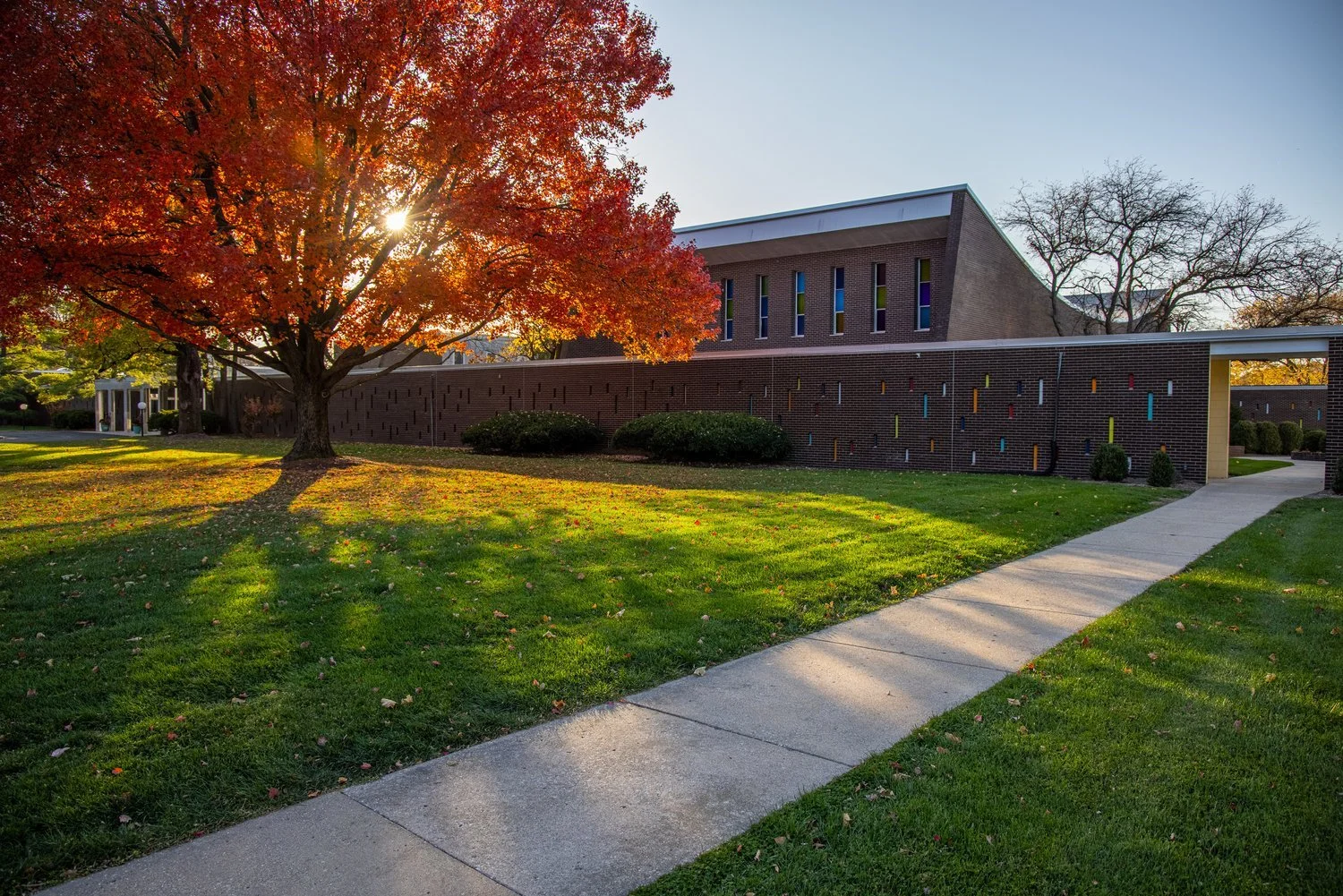A Sacred Architecture: The Novitiate & Motherhouse for the Sisters of the Third Order of St. Francis
Architect: Cletis Foley
by Edward J. Barry, Jr.
“In designing this project, the architect made no effort for a “strong architectural statement”. The project is located away from public view and every effort was devoted to creating an environment that was sensitive to the individuals, that would relate in scale to the people, and harmonize with the natural terrain.
Generous use was made of courtyards, a lake and various paths with points of interest to encourage inward reflection. The color of materials used on the exterior, dark brown brick and white precast panels, were selected to harmonize with the changing seasons. Two horizontal corridors were introduced to tie the two separate functions together with the Chapel as the center. It was a requirement of the program to have the Motherhouse Complex separated from the Novitiate Complex. Circulation was restricted to the periphery to provide maximum privacy within the various buildings.
This project was designed to fulfill not only the spatial requirements of the program, but hopefully, it fulfills a greater appreciation of buildings as a source of beauty, delight and inspiration.”
- Statement by Architect Cletis Roy Foley for 1967 Design Award Nomination to the Central Illinois Chapter of the American Institute of Architects
The Novitiate and Motherhouse campus for the Sisters of the Third Order of St. Francis, designed and built over a half-century ago, provided a remarkable opportunity to showcase the profound philosophies of 20th Century Modernist Movement.
Mister Foley’s design statement above gives a nod to those philosophies at every turn of phrase. The design was intended to make no strong architectural statement. It was to be in complete harmony with its natural surroundings. And, its meditative simplicity was to encourage inward reflection.
In short, an intensely collaborative union of both (modern) architecture and spirituality.
The Project
Located on a secluded 40-acre farmstead overlooking the Illinois River Valley, the OSF Novitiate and Motherhouse campus served four (4) distinct purposes. First among those was the Novitiate itself, which offered all the necessary facilities for the young women taking their vows as Sisters of the Third Order. This included a dormitory, dining hall and kitchen, laundry and sewing rooms, educational and recreational facilities, and a full complement of support rooms and spaces.
At the other end of life’s spectrum was the Motherhouse, offering a supportive and nurturing environment for those Sisters who had completed their lifetime of devoted service to the Third Order of Saint Francis. A mirror image of the full complement of residential facilities provided in the Novitiate, the Motherhouse added a specialized focus on the sheltered and convalescent care that would be required for the retired Sisters of the Order.
Complimenting and enhancing these two living environments (one for those just beginning their journey; the other for those at journey’s end) were to be found an administrative center, providing the offices, meeting rooms, and other spaces necessary to operate and manage this religious order. And, a full retreat and conference center for out-of-town guests who might interact with those living in the Novitiate or Motherhouse, while attending a wide variety of meetings, seminars, and other events.
The Style • Part One
The International or Modernist style of architecture that sprang to life during the 20th century was simple, bold, and powerful. It shunned the elaborate embellishments and ornament of its ancestors in favor of clean motifs that were free of decoration. It embraced simple, recognizable, and rational shapes in both plan and in volume that were the source of its strength. And, it usually punctuated those shapes and volumes with equally simple openings and structural supports. This formal and functional simplicity, this belief in everything rectangular, extended to the design of larger human constructions, such as towns, cities, and campuses like the OSF Novitiate & Motherhouse.
Cletis Roy Foley was a committed disciple of the International or Modernist architectural style and all that it embodied. He believed it was forward-thinking, on the cutting-edge, and signified the hopeful avant-garde. For the design of the OSF Novitiate and Motherhouse, he enlisted the Modernist vocabulary also because of its kinship with the spiritual zeitgeist of the Sisters of the Third Order. The dearth of decorative excess and the simplicity of shape, space, and volume were very much at one with their humility, their devotion, and their passionate religious beliefs.
Thus, the discreet buildings that Architect Foley created for the Novitiate and Motherhouse all share the same set of simple shapes and volumes, organized in powerful, rectangular ensembles, and clothed in simple dark brown bricks or white precast concrete panels. The only possible nod to the irrational is the freeform arrangement of small deep-set rectangular windows that puncture the large expanses of brick throughout, though even these seem to work together as a well-orchestrated and well-controlled pattern.
The Style • Part Two
The bold and rational Modernist architecture of the OSF Novitiate and Motherhouse is interrupted by three (3) important flourishes; namely, the Multipurpose Center, the Meditation Chapel, and the Transept of the Main Chapel. The latter two (2) campus elements employ the same palette of materials as the rest of the campus, so offer a flourish and a counterpoint primarily based on their round shape. This does give them both a special place in the larger ensemble, which is emblematic of their intense spiritual or sacred importance.
The Multipurpose Center represents a more dramatic and notable departure. Its expressive structural supports, its rhythmic arched openings to the simple glass walls behind, and its striking roofline all offer a nod to Brutalism. Such Brutalism served as a final phase of the 20th century Modernist Movement. A phase that some might say drifted architecture away from the human and the humane, and more towards an unwelcoming raw physicality. For Architect Foley, this third flourish meant that he had included and embraced all the main tenets of Modernism. And, perhaps more importantly, that he had provided the entire campus ensemble with an iconic center of focus.
The Nature
Long before the term “biophilia” entered the architectural lexicon, or the “Last Child in the Woods” movement was made famous, the OSF Novitiate and Motherhouse campus was carefully considering its intimate partnership with its natural surroundings. Harmony with the natural terrain, and with the changing seasons (both specifically mentioned in Architect Foley’s design statement quoted above), was accomplished by both overt and subtle means. Overtly, the campus included an ample ensemble of outdoor courtyards, whose spaces were carefully and powerfully defined by their surrounding edifices. And, a serene and nurturing lake was added that served as a reflective counterpoint to the adjacent and somewhat brutalist Multipurpose Building.
More subtly, Architect Foley would argue that the fundamental selection of the Modernist design paradigm and its vocabulary was supportive of biophilia and the important human-nature connection. By stylistically standing in stark contrast to its fluid natural surroundings, and not trying in any way to mimic or repeat them, the Modernist structures of the OSF Novitiate and Motherhouse were all working in careful concert with Nature.
Conclusion
The May/June 1968 issue of Catholic Market, the Magazine of Catholic Institutions, has an article and photo about the newly completed Novitiate and Motherhouse for the Sisters of the Third Order of Saint Francis.
This brief narrative is sprinkled in amongst advertisements for latest in aluminum pew kneelers and cafeteria milk dispensers, as well as articles about how a “Computer helps pastor know his parish”.
The article about the OSF Novitiate and Motherhouse ends by saying that the Sisters desired, “ . . . a complex that would exemplify a dignity and repose significant with their religious background.”
The disciples of the Modernist Movement, Cletis Roy Foley chief among them, would certainly concur that such dignity and repose had been heartily achieved.
Appendix • A Few Facts
Size of Campus: 121,830 Square Feet / 40 Acres
Cost of Campus: $2,772,529
Cost per Square Foot: $21.99
All Photography and Videography by Mouve Film













